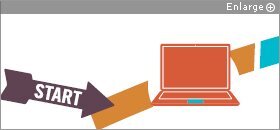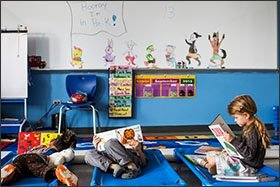This fall, about 65,000 4-year-olds—enough children to make a sizable school district of their own—started full-day prekindergarten in New York City.
The enrollment more than triples the number of full-day pre-K seats that were available just two years ago. Mayor Bill de Blasio campaigned on a promise of universal preschool and convinced the state legislature to provide $300 million to help launch it.
Ramping up so quickly turned into something akin to a political campaign, as the city blanketed communities with advertisements for the program, made person-to-person phone calls, went directly to local colleges to recruit the 2,000 new teachers needed for the effort, and sought classroom space in any location that could be made safe and appropriate for early learning.
Managing Growth
But the city’s effort has had ripple effects that are still being managed. For example, teachers working in district-run prekindergarten programs currently earn more than teachers based in community programs, though they have the same qualifications. There’s also competition for the city’s 100,000 4-year-olds, with some private and community organizations feeling like they’re losing out to district-run programs.
Some of the sharpest criticism has come from a University of California, Berkeley, education professor, who says that only programs targeted at poor children will close the academic gap, unlike the city’s program, which is available to all. City officials and other early-education experts vigorously dispute that assertion.
That criticism speaks to a deeper philosophical debate about city’s efforts, said Josh Wallack, the deputy chancellor of strategy and policy at the city’s education department. He said creating a pre-K program for children from poor families would have been akin to targeting any other regular school grade for a specific population, which no one would suggest.
“We see pre-K as a central part of the public education system in New York,” Wallack said, and prekindergarten is for all children.
So how does a city move from 20,000 full-day prekindergarten seats in 2013-14 to more than 65,000?
New York City launched an outreach effort to school parents in the options available to them under the city’s massive expansion of its free, full-day pre-K program, which enrolls about 65,000 children. If you’re the parent of a New York City 4-year-old in, here’s how the game is played.

SOURCE: New York City Department of Education
One important first step is finding a place to put all the children.
That’s how about 400 4-year-olds found themselves attending prekindergarten on two floors of a leased Roman Catholic high school in Brooklyn, N.Y.
When Bishop Ford Catholic High School closed in 2014, the city jumped at the chance to form a prekindergarten center in an area that was clamoring for early-childhood options. The wing of the building devoted to prekindergarten is divided into four quadrants named after quintessential New York landmarks: Times Square, Prospect Park, Coney Island, and the Bronx Zoo.
The classrooms currently lack some of the conveniences of a space purposely built for young children; for example, handwashing requires ushering groups of wiggly youngsters down a hall to the renovated bathrooms, because the classrooms don’t have sinks.
But the expansive space also allows for activities that a smaller center might not be able to support. A former science lab has been converted into a large “movement” classroom. Another classroom space serves as a science lab for young children. On a recent visit, the lab featured a huge sheet of tree bark and bundles of Spanish moss for the children to see and touch.
The Pre-K Center at Bishop Ford is in one of the city’s most desirable neighborhoods, dense with middle and higher-income families who chose the free pre-K program rather than pay thousands out of pocket for private prekindergarten. But the center is large enough to draw from several neighborhoods with low-income families, said Annika Kaye, a mentor teacher there.
“Having taught in the neighborhood for nearly 10 years now, I think it’s very diverse both economically and culturally,” Kaye said.
There are about 60 district-run prekindergarten centers around the city, which serve about 7,400 students, or a little more than 10 percent of the overall enrollment. But the city sees such centers as potential models for other programs, Wallack said.
Outreach is another crucial component of the expansion. As the city approaches its Oct. 31 final enrollment count, it is still trying to reach a large number of parents who have eligible children, but have not signed up.
Contacting Families
In a building near school district headquarters in lower Manhattan, about 40 people sit in low-walled cubicles, dialing the phone numbers of families who are seeking more information, families who registered but never showed up, and families who may not have received one of their top options for choosing a preschool. The outreach specialists can handle 10 languages among them, such as Spanish, Mandarin, Cantonese, Bengali, Russian, and Haitian Creole.

Community coordinators such as Ruvi Lopez are working the phones.
Lopez has a computer screen that can show the locations of programs with empty seats and the proximity of those centers to where a family lives. He focuses on the Northwest Bronx, where he grew up. He has been back to the area to walk the streets, to find out if a center that seems close to a family on a map is actually hard to get to because of geographic obstacles a map might not display.
The effort is similar to community organizing, and Lopez sees his work as a more than just getting children in schools—it’s a way to fight poverty. “It’s a combination of outreach, case work, and social work,” Lopez said.
The city has been able to offer a wide geographic spread of programs because prekindergarten is offered not only at schools, but at community-based organizations, or CBOs.
About 60 percent of the city program’s pre-K seats are at CBOs, such as the East Harlem Block Nursery. The organization has three child-care centers, including two located in public housing complexes. Kelly Haley, the interim administrative director, said the centers serve “the working poor,” more than 90 percent of whom are on some form of public assistance.
Competing for Children
But the city’s free prekindergarten program has meant some competition for the services her organization offers to 4-year-olds. For example, her families may have to pay a small fee. In return, they get a year-round program with before and aftercare, as opposed to the city prekindergarten program, which follows the school day and year.
Families balance no cost versus a small cost, and some are choosing to go with free programs, Haley said. The city-run prekindergarten programs also potentially allow children automatic entry into a well-regarded public elementary school. The East Harlem organization’s enrollment of 4-year-olds has dropped from 60 last school year to 32 this school year.
Pay disparities have also been an issue. In 2014, the city boosted the salaries of starting prekindergarten teachers that work in community-based organizations to $44,000. That’s still less than the $46,000 starting salary those same teachers would make if they moved to a district-run prekindergarten.
And teachers of children younger than 4 are not a part of the salary increase. They may be earning thousands less than their colleagues who teach 4-year-olds.
Haley still supports the city’s efforts. “But you don’t always know the consequences of a decision until you make it,” she said.
New York says it is working through the issues related to implementation. But one of the loudest critical voices has come from Bruce Fuller, a professor of education and public policy at the University of California, Berkeley.
He said that the city has done a good job in creating new prekindergarten seats in the city’s lowest-income ZIP codes, which he is using as a proxy for family-income levels of enrolled children. But he argues that because there is such a high proportion of children in those low-income ZIP codes, the city should have tilted even more strongly toward providing prekindergarten seats there.
He also says that the growth in seats between the first and second year of the program has been faster in middle and upper-income areas.
“We’ve got a half-century of research that shows that quality pre-K lifts poor kids,” he said. “We don’t have much evidence that verifies the same kinds of benefits for middle-class kids.”
Benefits for All
Fuller’s analyses are “maddeningly inaccurate,” said deputy press secretary Wiley Norvell, who works for the mayor’s office. The city made available thousands of full-day prekindergarten seats in low-income areas in its first year, Norvell said. In the second year, the growth in those neighborhoods was slower, but that just reflects the fact that the first year increase was so large.
The city believes that middle-income children can also benefit from a higher-quality program that has an educational component.
“We believe in the usefulness of a universal program,” Norvell said. “In a city that has decided to serve all families and to serve all families well, there’s no not serving one family in order to serve another.”
City officials believe that at this point, they have the seats they need to serve every child who wants it. Continuing efforts include focusing on professional development and creating a strong pre-K curriculum. New York’s efforts can ultimately serve as a national model, de Blasio said at a press conference earlier this month.
“This is a school system that certainly has its share of challenges and always had,” he said. “But we’re proving you can do something big and new and bold here.”






